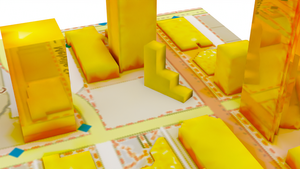Information
- Publication Type: Journal Paper with Conference Talk
- Workgroup(s)/Project(s):
- Date: April 2025
- Journal: Computer Graphics Forum
- Volume: 44
- Open Access: yes
- Number: 2
- Lecturer: Christian Freude
- Article Number: e70048
- ISSN: 1467-8659
- Event: Eurographics 2025
- DOI: 10.1111/cgf.70048
- Pages: 14
- Publisher: WILEY
- Conference date: 2025
- Keywords: Ray tracing, Physical simulation, Computer-aided design
Abstract
The early phase of urban planning and architectural design has a great impact on the thermal loads and characteristics of constructed buildings. It is, therefore, important to efficiently simulate thermal effects early on and rectify possible problems. In this paper, we present an inverse simulation of radiative heat transport and a differentiable photon-tracing approach. Our method utilizes GPU-accelerated ray tracing to speed up both the forward and adjoint simulation. Moreover, we incorporate matrix compression to further increase the efficiency of our thermal solver and support larger scenes. In addition to our differentiable photon-tracing approach, we introduce a novel approximate edge sampling scheme that re-uses primary samples instead of relying on explicit edge samples or auxiliary rays to resolve visibility discontinuities. Our inverse simulation system enables designers to not only predict the temperature distribution, but also automatically optimize the design to improve thermal comfort and avoid problematic configurations. We showcase our approach using several examples in which we optimize the placement of buildings or their facade geometry. Our approach can be used to optimize arbitrary geometric parameterizations and supports steady-state, as well as transient simulations.Additional Files and Images
Weblinks
BibTeX
@article{freude-2025-iso,
title = "Inverse Simulation of Radiative Thermal Transport",
author = "Christian Freude and Lukas Lipp and Matthias Zezulka and
Florian Rist and Michael Wimmer and David Hahn",
year = "2025",
abstract = "The early phase of urban planning and architectural design
has a great impact on the thermal loads and characteristics
of constructed buildings. It is, therefore, important to
efficiently simulate thermal effects early on and rectify
possible problems. In this paper, we present an inverse
simulation of radiative heat transport and a differentiable
photon-tracing approach. Our method utilizes GPU-accelerated
ray tracing to speed up both the forward and adjoint
simulation. Moreover, we incorporate matrix compression to
further increase the efficiency of our thermal solver and
support larger scenes. In addition to our differentiable
photon-tracing approach, we introduce a novel approximate
edge sampling scheme that re-uses primary samples instead of
relying on explicit edge samples or auxiliary rays to
resolve visibility discontinuities. Our inverse simulation
system enables designers to not only predict the temperature
distribution, but also automatically optimize the design to
improve thermal comfort and avoid problematic
configurations. We showcase our approach using several
examples in which we optimize the placement of buildings or
their facade geometry. Our approach can be used to optimize
arbitrary geometric parameterizations and supports
steady-state, as well as transient simulations.",
month = apr,
journal = "Computer Graphics Forum",
volume = "44",
number = "2",
articleno = "e70048",
issn = "1467-8659",
doi = "10.1111/cgf.70048",
pages = "14",
publisher = "WILEY",
keywords = "Ray tracing, Physical simulation, Computer-aided design",
URL = "https://www.cg.tuwien.ac.at/research/publications/2025/freude-2025-iso/",
}


 paper
paper
